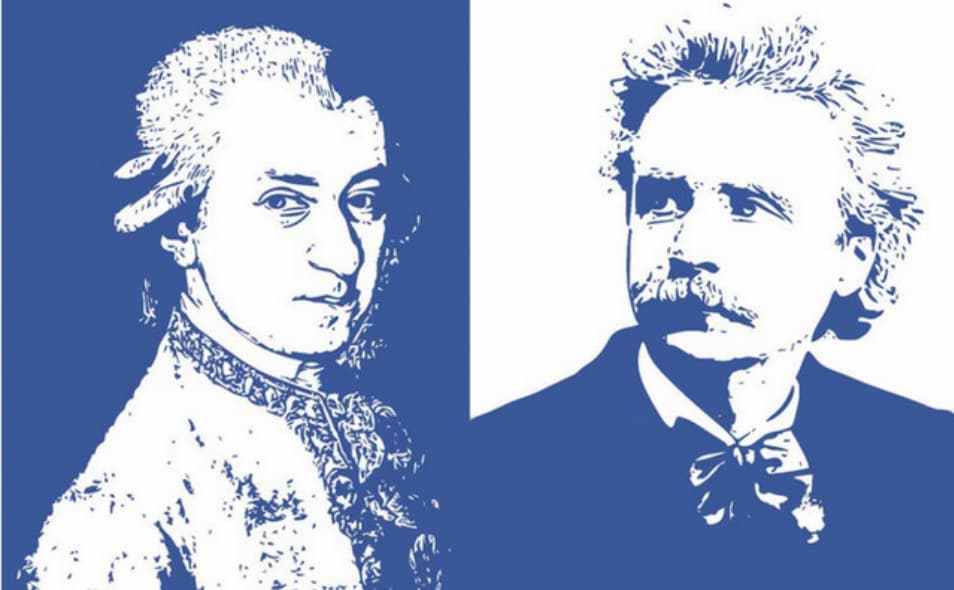In 1876, after returning from a trip to Bayreuth to see the first complete Ring cycles, Edvard Grieg and his friend John Paulson (1851–1924) travelled up and down Norway. As a treat for the poet Paulson, Grieg took 4 sonatas by Mozart and added a second piano part.

Mozart and Grieg
Think of Mozart being revisited with the contributions of later pianists: a Mozart / Beethoven work, or a Mozart / J.C. Bach collaboration, or a Mozart / Liszt mix. That’s really what Grieg accomplished in his new arrangements. He kept the original part, but, in a manner of speaking, ‘orchestrated’ it with the second piano part.
You can listen for yourself to his additions:
Wolfgang Amadeus Mozart: Piano Sonata No. 16 in C Major, K. 545, “Sonata facile” – I. Allegro (Maria João Pires, piano)
In his version, Grieg has added spread arpeggios and rapid scales.
Edvard Grieg: Mozart – Piano Sonata No. 16 in C Major, K. 545, “Sonata facile” (arr. for 2 pianos, EG 113) – I. Allegro (Sviatoslav Richter and Elisabeth Leonskaja, piano)
Wolfgang Amadeus Mozart: Piano Sonata No. 16 in C Major, K. 545, “Sonata facile” – II. Andante (Maria João Pires, piano)
In the middle movement, Grieg has added an Alberti bass.
Edvard Grieg: Mozart – Piano Sonata No. 16 in C Major, K. 545, “Sonata facile” (arr. for 2 pianos, EG 113) – II. Andante (Sviatoslav Richter and Elisabeth Leonskaja, piano)
Wolfgang Amadeus Mozart: Piano Sonata No. 16 in C Major, K. 545, “Sonata facile” – III. Rondo: Allegretto (Maria João Pires, piano)
In the final movement, Grieg has added echo effects, doubling the principal line, and transforming Mozart’s gallant style into something approaching a ‘neo-Lisztian virtuosity.’
Edvard Grieg: Mozart – Piano Sonata No. 16 in C Major, K. 545, “Sonata facile” (arr. for 2 pianos, EG 113) – III. Rondo: Allegretto grazioso (Sviatoslav Richter and Elisabeth Leonskaja, piano)
In romanticizing these quintessentially classical works, Grieg has approached them as someone who had admired Mozart since childhood. His first intent was to use these works for their didactic qualities but a couple of public concerts in the hands of other performers persuaded him that there was something more here.
Grieg’s ‘orchestrations’, or arrangements, or augmentations were daring moves for a composer who was still largely unpublished. The German publishers who turned the work down said they were waiting for authentic Grieg rather than re-processed Mozart, but now that Greig’s reputation is firmly established, we have reason to go back and look at these works again.
Grieg did arrangements of Mozart’s Piano Sonata No. 5 in G Major, K. 283; the Fantasia in C Minor, K. 475; and the Piano Sonata No. 15 in F Major, K. 533 + K. 494. Grieg’s arrangements bring the works into a 19th-century context. In answer to his critics, Greig wrote that if Mozart ‘were able to look down on us now, he would be bound to say, “You modern masters, why all this fuss? Why do you dress yourselves with all this exterior dignity? It has no bearing on your art; it simply destroys the original human sensitivity, the true salt of art”’.
It’s the joy of the amiability of Mozart and the complexities of the virtuosos of the 19th century, all bundled together in some very nice piano duos.
For more of the best in classical music, sign up for our E-Newsletter



